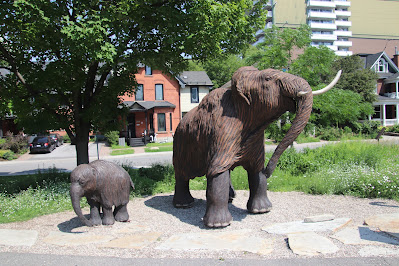The Woolly Mammoth sculpture stands on the grounds of the Canadian Museum of nature on the south side of McLeod Street about half way between O'Connor Street and Metcalfe Street.
The Woolly Mammoth
Icon of the Ice Age
DNA from fossil bones reveals that the woolly mammoth (Mammuthus primigenius) evolved around 350,000 years ago in North America. The life-sized replicas seen here were created by Canadian Museum of Nature sculptors in the 1980s. The are modelled after real fossils found in Siberia (MALE CALF), the Yukon (ADULT FEMALE), and Alaska (ADULT MALE). Notice the thick fur, small ears and short tails — all adaptations for surviving cold winters on the steppe.
The woolly mammoth is regarded as a keystone species. That means its foraging behaviour and pattern of travel across the land created the conditions responsible for the appearance and maintenance of the mammoth steppe as an ecosystem. Around the sculpture are plants that were found in the prehistoric steppe.
Le mammouth laineaux
Un symbole de l'ère glacieaire
L'analyse de l'ADN provenant des os fossiles idique que le mammouth laineux (Mammuthus primigenius) est apparu en Amérique du Nord il y a environ 350 000 and. Les reconstitutions grandeur nature que vous voyez ici ont été réalisées par des sculpteurs du Musée canadien de la nature dans les années 1980. Elles ont été modelées à partir de fossiles authentiques mis au jour en Sibérie (JEUNE MÂLE), au Yukon (FEMELLE ADULTE) et Alaska (MÂLE ADULTE). Remarquez l'épaisse fourrure, les petities oreilles et la queue courte, autant de traits d'adaptation aux hives froids de la steppe.
Le mammouth est considéré comme une espèce clé de voûte. Cela signifie que ses modes de broutage et de déplacement sur le territoire ont créé des conditions propices à l'apparition et au maintien de l'écosystème que constitue la steppe à mammouths. Les sculptures sont entourées de plantes qui existaient dans la steppe préhistorique.











